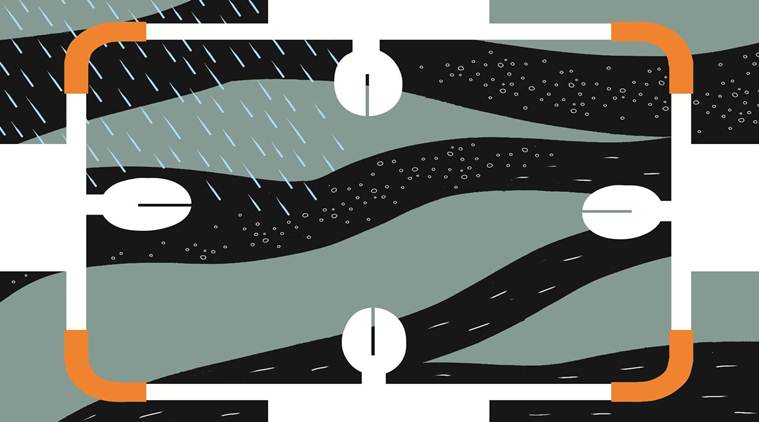Cities At Crossroads: Managing the run-off
An IIT Delhi report offers important pointers on how to ensure a smooth drainage system in the capital using its natural waterways.

There are many more recommendations. The problem arises because there are multiple government departments involved, with overlapping responsibility and no clear accountability. (Illustration: CR Sasikumar)
This is the time of year when Delhiites suffer floods and often do not know what to do and who to blame, because the multiple government authorities are busy pointing fingers at each other. Monsoon used to be the season when my generation, as children, used to look forward to some respite from the scorching summer. Now, we protect our children from waterlogged areas in the city, worried that much of the water on the ground may well be mixed with sewage.
A long-awaited report on ‘How to Make Drainage Work in the National Capital Territory of Delhi’, prepared by Professor A K Gosain and his team from IIT Delhi, has just been submitted to the Department of Irrigation and Flood Control of the government of Delhi. The contributors to the study include “insiders”, that is, people from municipal corporations, Public Works Department (PWD), Irrigation and Flood Control Department, Delhi Jal Board (DJB) and Delhi Development Authority (DDA). The report spells out what is needed to ensure that the drainage system in Delhi works efficiently.
There are three major drainage basins in the NCT of Delhi — Najafgarh, Barapullah and Trans-Yamuna basins — and, there are 22 natural drainage systems in these basins which outfall into the Yamuna somewhere during its 46 km-run through Delhi. There are 201 sub-segments of the natural drains in these networks. These “drains” are actually the waterways that carry the run-offs from the plains to the river Yamuna and also recharge groundwater, besides supporting biodiversity. Calling them natural drains that provide safe exit to stormwater including floodwaters, understates their ecological significance.
The IIT team reports that many of these channel drains have been encroached and are disappearing: 19 out of the 201 natural drains mentioned in the 1976 Master Plan of the Delhi Government cannot even be traced today. Of the rest, some are filled with solid waste and, sometimes, construction debris; Others carry sewage and hence function as sewers.
The IIT team did not have all the necessary data. They had to take recourse to interpolation and engineering judgement on cross sections and invert levels of drains, flow directions, outfalls, etc to conduct simulations of the stormwater management model for each of the three basins. Armed with these simulations they have come up with detailed recommendations on how to make Delhi’s drainage work. They have looked at large drains (four feet and deeper), while drawing attention to the importance of other drains being functional for the system to be efficient. City managers also need to evaluate the road system in the city for design flaws that might be aggravating the waterlogging problems.
The recommendations that emerge from the complex exercises in the IIT report are very simple and doable. The major ones are: One, no encroachment of any storm-water drain should be allowed. Special drives must be conducted to remove existing encroachments. It would require tremendous political will to implement this recommendation. A typical pattern seems to be to first use the open drain as a garbage dump and then, with the passage of time, clear the dump, cover the drain and use the area for the purpose of building a market, a bus depot or any other urban amenity — thus sacrificing the resilience of the city. A lot of wrongs that have been done will have to be undone. The public and the media should highlight encroachments when they begin, to prevent their completion. Two, no construction should be allowed inside any stormwater drains. Two egregious examples of this principle’s violation are the laying of utilities inside the stormwater drains and building of pillars of elevated roads/metro inside the drains. Three, the sewerage network should be totally separated from the drainage network. Only stormwater and treated sewage of acceptable quality as per the norms of the Central Pollution Control Board should be allowed in the stormwater drains. Thanks to a ruling by the National Green Tribunal (NGT) in 2015, the DJB has come up with a Master Plan for interceptor sewers to trap the sewage coming out of unsewered and unauthorised colonies, and to take the same to the nearest sewer line rather than dumping it in the nearest stormwater drain. They are working to implement the plan by December 2018. However, in the areas which are connected to a sewerage network, the DJB has, for years, been following a practice of puncturing sewer lines and draining sewage into stormwater drains in the event of blockage. The recommendation of the IIT team is that this must be explicitly forbidden and the DJB should use other available equipment for de-clogging the sewer lines.
Four, no solid waste or garbage is to be dumped into stormwater drains, e.g., Pankha Road (‘Choking the city’, IE, August 31, 2016). Not only is this a public health hazard but it also provides temptation to cover the drain with the passage of time, as has happened in Defence Colony and South Extension, among other places. The NGT Order of March 2014 on Yamuna rejuvenation and a policy statement by the Delhi government in response to directions from the High Court of Delhi, specifically prohibit covering any natural stormwater drain in the city.
Five, no silt from the road (before or after road sweeping — manual or otherwise) should be allowed to be dumped into bell-mouths that lead to drains on the side of the road. The report emphasises that this would require a complete overhaul of the road sweeping process and suggests a monitoring mechanism to ensure compliance.
Six, no Construction and Demolition (C&D) waste should be allowed to be dumped into stormwater drains and, further, that the amount of waste from a construction site should be estimated in advance and lifted by government-appointed contractors for dumping at C&D processing sites. This is also likely to be resisted by developers and builders, and enforcement must be taken up on war footing.
Finally, access points for covered drains must be provided at an appropriate distance so that desilting of drains can be carried out regularly. Most of the covered drains currently do not have access for desilting. The report recommends that a schedule of desilting should be displayed in a manner that is understood clearly by the general public.
There are many more recommendations. The problem arises because there are multiple government departments involved, with overlapping responsibility and no clear accountability. The stormwater drains are under the jurisdiction of the different Municipal Corporations, Public Works Department or the Irrigation and Flood Control Department, depending on their size. The sewerage network, on the other hand, is the responsibility of DJB.
Whether or not there is a single institution responsible and accountable for drainage management as recommended by the report, it is clear that there is an urgent need for strong co-ordination across departments and fixing accountability at every level. We also need a mechanism for public oversight and prompt remedial follow-up.
Finally, as pressures of urbanisation lead to greater concretisation in our cities, we need to work harder to rejuvenate our urban water bodies, use parks and green spaces for rainwater harvesting, and also use bioswales to manage and filter the storm water runoff.
The writer is chairperson, ICRIER, Delhi, and former chairperson of the high-powered expert committee on urban infrastructure and services.
For all the latest Opinion News, download Indian Express App
More From Isher Judge Ahluwalia
- Ripples of reform in DhakaBangladesh capital’s transformation of the water services sector, that connects the urban poor to the piped network, has lessons for cities in India..
- Cities at Crossroads: Who pays to save this lake?Bengaluru waterbody, Jakkur, restored by a citizen’s initiative, now stands to be deprived of water by a power plant, raising questions about making environmentally sound…
- Cities at Crossroads: Bring back the lakesCitizen action on rejuvenation of water bodies is gathering momentum in Bengaluru and is making a difference on the ground...








































No hay comentarios:
Publicar un comentario